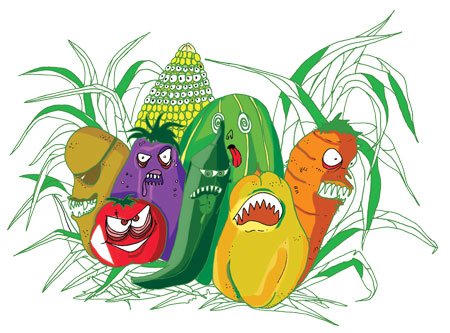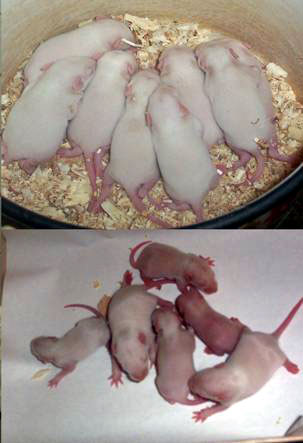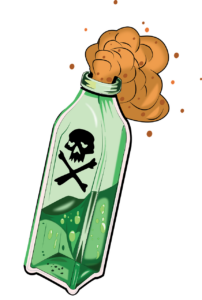How do GM foods affect your health?

The American Academy of Environmental Medicine (AAEM) is asking physicians to prescribe diets WITHOUT GM foods to ALL patients, stating: “Several animal studies indicate serious health risks associated with GM food, including infertility, immune problems, accelerated aging, insulin regulation, and changes in major organs and the gastrointestinal system . . .There is more than a casual association between GM foods and adverse health effects. There is causation. . .”
– The American Academy of Environmental Medicine (AAEM)
Don't expect Monsanto's government "implants" at the FDA to protect you!
Monsanto’s “Inside” Man at the FDA
The White house ordered the FDA to promote biotechnology, and former Monsanto attorney, Michael Taylor, headed up the FDA’s GMO policy, declaring that no safety studies on GMOs are required, since Monsanto and other producers determine if their foods are safe!
FDA scientists warned Taylor that GM foods might create allergies, poisons, new diseases, and nutritional problems (according to documents released from a lawsuit). In the decision on whether GMOs had to be labeled or whether they had to be tested, Taylor claimed that the agency was not aware of any information showing that the foods created by genetic engineering were significantly different and therefore no testing and no labeling were required. Now, documents made public from a lawsuit showed that it was a lie. In fact, the overwhelming consensus among the FDA’s own scientists were that GM foods were inherently dangerous and could create allergies, toxins, new diseases, and nutritional problems and of course they should be labeled because they are a food additive and food additives that are new and like that should have been labeled.
- Taylor later became Monsanto’s vice president, and was reinstalled at the FDA in 2009 by the Obama administration as the “US Food Safety Czar”
Serious conflicts of interest even in the U.S. Supreme court – Supreme Court Justice Clarence Thomas is also a former Monsanto attorney, but refused to acknowledge any conflict of interest as he heard Monsanto’s third appeal for deregulation of genetically modified alfalfa seeds (approved in 2011). After corn, soy and wheat, alfalfa is the most widely grown crop in the U.S.. Alfalfa is easily cross-pollinated by bees and wind, and it’s a perennial, meaning GM alfalfa could live on for years, spreading their GM traits far and wide for a long period of time.
Bayer’s (was Monsanto’s before 2016 merger) rBGH (GM hormone given to cows to increase milk yield) has been banned in Canada (since 1999), New Zealand, Japan, Australia and all European Union nations, but still permitted in the U.S.. rBGH was approved by the U.S. FDA in 1993. Since then, accumulating scientific evidence has been enough for other governments to prohibit the use of rBGH, which shows a significant risk for initiating / promoting cancer. Award-winning journalists from FOX news won a wrongful termination case (later over-turned on a technicality), when they were fired by FOX news (under strong pressure from Monsanto) for refusing to lie about what they had discovered about health problems caused by rBGH. Monsanto and Fox TV Unite to Suppress Journalists’ Free Speech

GM foods cause reproductive problems

In the U.S., incidence of low birth-weight babies, infertility and infant mortality are escalating, and may possibly be associated with increasing GMO’s
The following information on animal studies taken from an interview by Dr. Joseph Mercola in 2010 with Jeffrey M Smith, author of the bestseller Seeds of Deception YouTube
Hamster study
Russian scientists find 3rd generation hamsters are sterilized by GM soy! This study was conducted by the Russian equivalent of the US National Association for Gene Security. This study confirms earlier problems related to fertility, birth weight of offspring, and infant mortality. In this feeding study they used hamsters – an animal not previously featured in GM safety studies.
| Hamster Study Groups | Food Eaten |
|---|---|
| Group 1 (Control) | Normal diet without any soy |
| Group 2 | Non-GMO soy |
| Group 3 | GM soy |
| Group 4 | Higher amount of GM soy than Group 3 |
Using the same genetically modified (GM) soy that is produced on over 90% of the soy acreage in the US, the hamsters and their offspring were fed their respective diets over a period of two years, during which time the researchers evaluated three generations of hamsters. First, they took five pairs of hamsters from each group, each of which produced about seven to eight litters each, totaling about 140 animals. All went well at the start, but serious problems became apparent when they selected new pairs from the offspring:
1st problem – the second generation had a slower growth rate and reached their sexual maturity later than normal.
However, this second generation eventually generated another 39 litters:
- The no-soy control group had 52 pups
- The non-GM soy had 78
- The GM soy had only 40, of which 25% died
2nd Problem – the second-generation GM soy-fed hamsters had a five-fold higher infant mortality rate, compared to the 5% normal death rate of the controls.
3rd Problem – Nearly All of the Third-Generation GMO lost the ability to have babies altogether! Only a single third-generation female hamster gave birth to 16 pups, and of those, one fifth died.
4th Problem – hair growing inside the animals’ mouths – an unusually high prevalence was found in the GM soy-fed groups of an otherwise extremely rare phenomenon – You can see the images here. Says Jeffrey Smith, “. . . it’s a very rare phenomenon but he [study author, Dr. Surov] had never in his life seen more hair in mouths of hamsters than with these GM soy-fed, third generation hamsters.”
GM crops weren’t released until 1996, starting with GM soy, corn and cotton. Modified canola came about a year later.Thus, since humans have a much longer life span than hamsters, in comparison, we are only 15 years into the first generation since GMO introduction [interview in 2010], but if we experience similar effects of the hamsters, we could be looking at sterility on a grand scale as our great-grandchildren grow up and try to procreate…
Rat study
50% of babies of mother rats fed GM soy flour died within 3 weeks – compared to 10% death rate of those fed natural soy flour. Again, that’s a death rate five times higher than normal -identical to the findings in the hamster study above;
2nd generation of rats found mostly sterile – Also similar to the hamster study above, surviving GM-fed babies had lower birth weights, grew more slowly, and again, when the rats’offspring tried to reproduce, they too were found to be mostly sterile, but it happened sooner, with infertility striking the second generation of rats, as opposed to the third generation of hamsters.
Litter from female rat fed GM soy (bottom) compared with control (from Dr. Erina Ermakova) Ermakova I, 2006) Ermakova I, 2007
GM soy-fed male rats testicles changed from normal pink to dark blue
- When Ermakova, senior researcher at the Russian National Academy fed GM soy to male rats, it changed the color of their testicles from pink to blue, and that the structure of the cells in the testicle was different; a completely different blood flow.
- In Italy, when they fed mice GM soy, the mice had changes in their testicles, including damage to the young sperm cells- which could cause infertility, or problems with the offspring. It appears that they may have had both – they removed the embryos from the pregnant mothers and found that the DNA functioned differently in those who were born to GM soy-fed parents vs. those who were fed non-GM soy.
Underhanded “goings-on”. Ermakova wanted to perform further studies to analyze the organs she’d collected from the study, but she never got the chance. Jeffrey Smith relates: “She told me as we were sitting at the EU Parliament after giving a presentation there, that her boss had been pressured by his boss. So, she was told to do no more GM food study on animals. Her documents were burned on her desk, samples were stolen from her laboratory..”
Inadvertently, however, she stumbled upon further proof that GM soy wreaks havoc with reproductive health, when she discovered that the food being fed to all rats in the facility had been switched, so that all of it contained GM soy. Two months later she asked her colleagues whether or not they’d discovered any surprising changes in the infant mortality of their various studies, and find out that inexplicably, infant mortality in the animal studies performed at the National Academy of Scientific Laboratory in Moscowhad skyrocketed to over 55%, sometimes higher!
Other disturbing observations on GMO reproductive effects.
Most buffalo fed GM cottonseed had reproductive complication in Haryana, India. Includes. premature deliveries, abortions, infertility; many calves died. Jeffrey M. Smith, Genetically Modified Foods: Toxins and Reproductive Failures
Pigs of two dozen U.S. farmers became sterile when fed certain GM corn varieties –some had false pregnancies, others delivered bags of water; cows and bulls became infertile.

GMOs provoke immune reactions
- Immune status changes consistently feature in all animal studies (according to GMO safety expert Arpad Pusztai);
- Monsanto’s own research to government-funded trials revealed that rodents fed Bt corn had significant immune reactions. Burns JM, 2002; Finamore A, et al, 2008;
GM soy and corn contain new proteins with allergenic properties
- Damaged soy DNA creates new (or more) allergens – The usual understanding is that genetic engineering imports genes that produce new proteins that may provoke allergies by triggering reactions. E.g. In the mid 1990s soybeans were outfitted with a gene from the Brazil nut, but the attempt to produce a healthier soybean ended up with a potentially deadly one. Blood tests showed that people allergic to Brazil nuts reacted to the beans and it was never marketed.
Creating a GM crop can cause native genes to be mutated, deleted, permanently turned on or off, and hundreds may change their levels of protein expression, which can increase existing allergens, or produce new, unknown allergens, both of which seems to have happened in GM soy.
- GM soy has up to seven times more of a known soy allergen. Levels of the soy allergen, trypsin inhibitor, were up to seven times higher in cooked GM soy compared to cooked non-GM soy. Zolla L et al, 2008; Hye-Yung Yum et al, 2005; Gendel,1998; Pusztai A et al, 2005;
- One study discovered a unique, unexpected protein in GM soy – likely to trigger allergies.
- Soy allergies soared soon after GM soy was introduced to the UK –skyrocketing by 50%.
- Safety precautions ignored – GM soy (91% of US soy acres) is called Roundup Ready, designed to survive otherwise deadly applications of Monsanto’s Roundup herbicide. The plants contain genes from bacteria, which produce a protein that has never been part of the human food supply. As a precaution, scientists compare this new protein with a database of proteins known to cause allergies. According to criteria recommended by WHO and others, if the new GM protein contains amino acid sequences that have been shown to trigger immune responses in other proteins, the GM crop should not be commercialized without additional testing. However, sections of the protein produced in GM soy are identical to shrimp and dust mite allergens, and the soybean got marketed anyway.

Genes inserted into GMO food transfer large DNA fragments into human bloodstream
Bt genes transfer into GM plants Mohamed Abbas, 2018
- Since the 1930’s the bacterium Bacillus thuringiensis (Bt) and its toxins have been extensively used for insect pest control in agriculture and forestry. When Bt cells develop spores, protein crystals (called Cry proteins) harmful to certain insect groups (specific species belonging to orders: Lepidoptera, Coleoptera, Hymenoptera, Diptera, and Nematoda) are synthesised during sporulation. The most wodely used Bt vegetable crop is sweet corn.
- Transgenic plants containing Bt genes, commercially available since the 1990s, are developed by transferring genes to produce specific Cry proteins like CryIAc and Cry2AB. It is presumed the genes perform the same function of producing the toxin in the plant as they were doing in the bacterium and hence are safe for the environment. This can only occur where processing methods keep the DNA intact E.g. corn on the cob, corn chips, corn tortillas, corn flour, which undergo a normal wet-mill process involving just cooking and texturizing, as opposed to more intense processing involving the addition of enzymes to breakdown proteins. Thus, eating corn chips might transform your intestinal bacteria into a living pesticide factory.
GMO DNA survives the digestive tract and transfers to bloodstream after consumption of GM meal. A 2014 human study published in the prestigious journal PLOS ONE found large DNA fragments from GM foods can be directly transferred into the bloodstream. Researchers in the U.S., Denmark and Hungary analysed over 1,000 samples from four independent trials. 10 years earlier, the only other similar human study concluded that GMO DNA is harmless after the digestion process, since only a low level survived the digestive tract after consumption of GMO soy meal Netherwood et al, 2004

Animals die after eating GM plants
Almost EVERY species of animal that is offered a GMO food versus a non-GMO food will avoid the GMO one – a convincing clue as to the dangers of GM foods . . . Many times they will do this to the point of starvation, as they have an intuitive sense of the danger of this food:
Thousands of sheep grazing on GM cotton plants died. In India, animals typically graze on cotton plants after harvest, but when shepherds allowed sheep to graze on Bt-cotton plants, thousands died. Investigators said preliminary evidence “strongly suggests that the sheep mortality was due to a toxin. . . . most probably Bt-toxin.” In one small study, all sheep fed Bt cotton plants died; those fed natural plants remained healthy. “Mortality in Sheep Flocks after Grazing on Bt Cotton Fields, 2006
All of a group of buffalo grazing on Bt-cotton plants for first time died within 3 days. In the village of Andhra Pradesh, buffalo had grazed on cotton plants for eight years without incident. On January 3rd, 2008, 13 buffalo grazed on Bt-cotton plants for the first time and all died within three days. Jeffrey Smith — Doctors Warn: Avoid Genetically Modified Food
Bt-corn is implicated in animal / bird deaths:
- 7 of 40 rats died within two weeks of eating a GM tomato . Original study Burns JM, 2002 Conclusions that all was normal was contested by Arpad Pusztai, PhD, 2002, one of the world’s leading experts in GM food safety assessments
- Twice the number of chickens fed Liberty Link corn died compared to controls. A study submitted and accepted Leeson S, 1996 involving 280 young broiler chickens concluded ‘Results of live bird traits … show that source of corn … had no effect on body weight, feed intake, … or percent mortality over the experimental period …’The mortality rate was judged to be normal. However, reexamination by Dr Eva Novotny, SGR, to the Royal Society, April 2001 pointed out study errors in body weights, food consumption and mortality, that twice as many deaths occurred amongst the chickens eating the glufosinate-resistant maize (7.14 ± 5.47 % compared with those fed commercial hybrid corn (3.57 ± 5.47 %). Novotny Eva Dr., 2001
- Cows in Germany, horses, water buffaloes, and chickens in the Philippines – Jeffrey M. Smith, 2007

Overwhelming GMO evidence / cover-ups
The following is an article by Jeffrey Smith, renowned author and a knowledgeable resource on GMOs tells of the overwhelming evidence discovered by scientists on the serious and irreversible harm ensuing from GMO’s in our diet today, and lets you know the great lengths that companies go to in an effort to cover- up this evidence and discredit these brave whistle-blowing scientists: Jeffrey Smith — Doctors Warn: Avoid Genetically Modified Food
International bestselling author and filmmaker Jeffrey Smith is the leading spokesperson on the health dangers of genetically modified (GM) foods. His first book,Seeds of Deception, is the world’s bestselling and #1 rated book on the topic. His second,Genetic Roulette: The Documented Health Risks of Genetically Engineered Foods, provides overwhelming evidence that GMOs are unsafe and should never have been introduced.
Mr. Smith is the executive director of the Institute for Responsible Technology, whose campaign is to create the tipping point of consumer rejection of GMOs, forcing them out of our food supply.
Concerned scientists willing to put their careers on the line by speaking out
Arpad Pusztai
Biologist Arpad Pusztai had more than 300 articles and 12 books to his credit and was the world’s top expert in his field, but when he accidentally discovered that genetically modified (GM) foods are dangerous, he became the biotech industry’s bad-boy poster child, setting an example for other scientists thinking about blowing the whistle. In the early 1990s, Dr. Pusztai was awarded a $3 million grant by the UK government to design the system for safety testing genetically modified organisms (GMOs). His team included more than 20 scientists working at three facilities, including the Rowett Institute in Aberdeen, Scotland, the top nutritional research lab in the UK, and his employer for the previous 35 years.
The results of Pusztai’s work were supposed to become the required testing protocols for all of Europe. But when he fed supposedly harmless GM potatoes to rats, things didn’t go as planned. Within just 10 days, the animals developed potentially pre-cancerous cell growth, smaller brains, livers, and testicles, partially atrophied livers, and damaged immune systems. Moreover, the cause was almost certainly side effects from the process of genetic engineering itself. In other words, the GM foods on the market, which are created from the same process, might have similar effects on humans.
With permission from his director, Pusztai was interviewed on TV and expressed his concerns about GM foods. He became a hero at his institute — for two days. Then came the phone calls from the pro-GMO prime minister’s office to the institute’s director. The next morning, Pusztai was fired. He was silenced with threats of a lawsuit, his team was dismantled, and the protocols never implemented. His Institute, the biotech industry, and the UK government together launched a smear campaign to destroy Pusztai’s reputation. Eventually, an invitation to speak before Parliament lifted his gag order and his research was published in the prestigious Lancet. No similar in-depth studies have yet tested the GM foods eaten every day by Americans.
Irina Ermakova
Irina Ermakova, a senior scientist at the Russian National Academy of Sciences, was shocked to discover that more than half of the baby rats in her experiment died within three weeks. She had fed the mothers GM soy flour purchased at a supermarket. The babies from mothers fed natural non-GMO soy, however, only suffered a 10% death rate. She repeated her experiment three times with similar results. Dr. Ermakova reported her preliminary findings at a conference in October 2005, asking the scientific community to replicate her study. Instead, she was attacked and vilified. Her boss told her to stop doing anymore GM food research. Samples were stolen from her lab, and a paper was even set fire on her desk. One of her colleagues tried to comfort her by saying, “Maybe the GM soy will solve the overpopulation problem.”
Of the mostly spurious criticisms leveled at Ermakova, one was significant enough to raise doubts about the cause of the deaths. She did not conduct a biochemical analysis of the feed. Without it, we don’t know if some rogue toxin had contaminated the soy flour. But more recent events suggest that whatever caused the high infant mortality was not unique to her one bag of GM flour. In November 2005, the supplier of rat food to the laboratory where Ermakova worked began using GM soy in the formulation. Allthe rats were now eating it. After two months, Ermakova asked other scientists about the infant mortality rate in their experiments. It had skyrocketed to over 55 percent. It’s been four years since these findings were reported. No one has yet repeated Ermakova’s study, even though it would cost just a few thousand dollars.
Andres Carrasco
Embryologist Andres Carrasco told a leading Buenos Aires newspaper about the results of his research into Roundup; the herbicide sold in conjunction with Monsanto’s genetically engineered Roundup Ready crops. Dr. Carrasco, who works in Argentina’s Ministry of Science, said his studies of amphibians suggest that the herbicide could cause defects in the brain, intestines, and hearts of fetuses. Moreover, the amount of Roundup used on GM soy fields was as much as 1,500 times greater than that which created the defects. Tragically, his research had been inspired by the experience of desperate peasant and indigenous communities who were suffering from exposure to toxic herbicides used on the GM soy fields throughout Argentina.
According to an article in Grain, the biotech industry “mounted an unprecedented attack on Carrasco, ridiculing his research and even issuing personal threats.” In addition, four men arrived unannounced at his laboratory and were extremely aggressive, attempting to interrogate Carrasco and obtain details of his study. “It was a violent, disproportionate, dirty reaction,” he said. “I hadn’t even discovered anything new, only confirmed conclusions that others had reached.”
Argentina’s Association of Environmental Lawyers filed a petition calling for a ban on Roundup, and the Ministry of Defense banned GM soy from its fields.
Judy Carman
Epidemiologist Judy Carman used to investigate outbreaks of disease for a state government in Australia. She knows that health problems associated with GM foods might be impossible to track or take decades to discover. Moreover, the superficial, short-term animal feeding studies usually do not evaluate “biochemistry, immunology, tissue pathology, gut function, liver function, and kidney function”and are too short to test for cancer or reproductive or child health.
Dr. Carman has critiqued the GMO approval process on behalf of the Public Health Association of Australia and speaks openly about her concerns. As a result, she is repeatedly attacked. Pro-GM scientists threatened disciplinary action through her Vice-Chancellor, and circulated a defamatory letter to government and university officials.
Carman was awarded a grant by the Western Australia government to conduct some of the few long-term animal feeding studies on GMOs. Apparently concerned about what she might find, GMO advocates wrote letters to the government demanding that the grant be withdrawn. One scientist tried to convince the Western Australia Agriculture minister that sufficient safety research had been conducted and he should therefore cancel the grant. As his evidence, however, he presented a report summarizing only 60 GMO animal feeding studies — an infinitesimal amount of research to justify exposing the entire population to GM foods. A closer investigation, however, revealed that most of the 60 were not safety studies at all. They were production studies, measuring, for example, the animals’carcass weight. Only 9 contained data applicable to human health. And 6 of the 9 showed adverse effects in animals that ate GM feed!
Furthermore, there were several other studies with adverse findings that were mysteriously missing from the compilation. Carman points out that the report “does not support claims that GM crops are safe to eat. On the contrary, it provides evidence that GM crops may be harmful to health.” When the Western Government refused to withdraw the grant, opponents successfully interfered with Carman’s relationship with the university where she was to do the research.
Terje Traavik
Prominent virologist Terje Traavik presented preliminary data at a February 2004 meeting at the UN Biosafety Protocol Conference, showing that:
- Filipinos living next to a GM cornfield developed serious symptoms while the corn was pollinating;
- Genetic material inserted into GM crops transferred to rat organs after a single meal; and
- Key safety assumptions about genetically engineered viruses were overturned, calling into question the safety of using these viruses in vaccines.
The biotech industry mercilessly attacked Dr. Traavik. Their excuse? — he presented unpublished work. But presenting preliminary data at professional conferences is a long tradition in science, something that the biotech industry itself relied on in 1999 to try to counter the evidence that butterflies were endangered by GM corn. Ironically, three years after attacking Traavik, the same biotech proponents sharply criticized a peer-reviewed publication forNOTciting unpublished data that had been presented at a conference. The paper shows how the runoff of GM Bt corn into streams can kill the “caddis fly,”which may seriously upset marine ecosystems. The study set off a storm of attacks against its author, ecologist Emma Rosi-Marshall, whichNaturedescribed in a September 2009 article as a “hail of abuse.”
Companies prevent studies on their GM crops by witholding seeds and genes
When Ohio State University plant ecologist Allison Snow discovered problematic side effects in GM sunflowers, Pioneer Hi-Bred International and Dow Agro Sciences blocked further research by withholding GM seeds and genes. After Marc Lappé and Britt Bailey found significant reductions in cancer-fighting isoflavones in Monsanto’s GM soybeans, the seed seller Hartz told them they could no longer provide samples. Research by a plant geneticist at a leading US university was also thwarted when two companies refused him GM corn. In fact, almost no independent studies are conducted that might find problems. According to a scathing opinion piece in an August 2009 Scientific American, “Agritech companies have given themselves veto power over the work of independent researchers … Only studies that the seed companies have approved ever see the light of a peer-reviewed journal.”
A group of 26 corn insect scientists protested this restriction in a letter submitted to the Environmental Protection Agency. They warned that the inability to access GM seeds from biotech companies means there can be no truly independent research on the critical questions. The scientists, of course, withheld their identities for fear of reprisals from the companies.
Restricted access is not limited to the US. When a Japanese scientist wanted to conduct animal feeding studies on the GM soybeans under review in Japan, both the government and the bean’s maker DuPont refused to give him any samples. Hungarian Professor Bela Darvas discovered that Monsanto’s GM corn hurt endangered species in his country. Monsanto immediately shut off his supplies. Dr. Darvas later gave a speech on his preliminary findings and discovered that a false and incriminating report about his research was circulating. He traced it to a Monsanto public relations employee, who claimed it mysteriously appeared on her desk — so she faxed it out.
GMO contamination: Don’t ask and definitely don’t tell
 In 2005, a scientist had gathered seed samples from all over Turkey to evaluate the extent of contamination by GM varieties. According to the Turkish Daily News, just before her testing was complete, she was reassigned to another department and access to her lab was denied. The unexpected transfer may have saved this Turkish scientist from an even worse fate, had she discovered and reported contamination.
In 2005, a scientist had gathered seed samples from all over Turkey to evaluate the extent of contamination by GM varieties. According to the Turkish Daily News, just before her testing was complete, she was reassigned to another department and access to her lab was denied. The unexpected transfer may have saved this Turkish scientist from an even worse fate, had she discovered and reported contamination.
Ask Ignacio Chapela, a microbial ecologist from UC Berkeley. In 2001, he discovered that the indigenous corn varieties in Mexico — the source of the world’s genetic diversity for corn—had become contaminated through cross pollination with GM varieties. The government had a ban against GM corn to prevent just this possibility, but apparently US corn imported for food had been planted nonetheless.
Dr. Chapela submitted the finding to Nature, and as a courtesy that he later regretted, informed the Mexican government about the pending publication. He was called in to meet with a furious Director of the Commission of Biosafety and GMOs. Chapela’s confirmation of contamination would hinder introduction of GM corn. Therefore the government’s top biotech man demanded that he withdraw his article. According to Chapela, the official intimidated and threatened him, even implying, “We know where your children go to school.” When a traumatized Chapela still did not back down, the Underminister for Agriculture later sent him a fax claiming that because of his scientific paper, Chapela would be held personally responsible for all damages caused to agriculture and to the economy in general.
The day Chapela’s paper was published, Mary Murphy and Andura Smetacek began posting messages to a biotechnology listserve called AgBioWorld, distributed to more than 3,000 scientists. They falsely claimed that Chapela was biased, that his paper had not been peer-reviewed, that Chapela was “first and foremost an activist,” and his research was published in collusion with environmentalists. Soon, hundreds of other messages appeared, repeating or embellishing the accusations. The listserve launched a petition and besieged Nature with a worldwide campaign demanding retraction.
UC Berkeley also received letters from all over the world trying to convince them not to grant Chapela tenure. He had overwhelming support by his college and department, but the international biotech lobby was too much. Chapela’s tenure was denied. After he filed a lawsuit, the university eventually reversed its decision. When investigators later analyzed the email characteristics sent by agitators Mary Murphy and Andura Smetacek, the two turned out not to be the average citizens they claimed. According to the Guardian, both were fabricated names used by a public relations firm that worked for Monsanto. Some of Smetacek’s emails also had the internet protocol address of gatekeeper2.monsanto.com — the server owned by Monsanto.
Science and debate is silenced
The attacks on scientists have taken its toll. According to Dr. Chapela, there is a de facto ban on scientists “asking certain questions and finding certain results.”He says, “It’s very hard for us to publish in this field. People are scared.”He told Nature that young people “are not going into this field precisely because they are discouraged by what they see.”
New Zealand Parliament member Sue Kedgley told a Royal Commission in 2001: “Personally I have been contacted by telephone and e-mail by a number of scientists who have serious concerns about aspects of the research that is taking place … and the increasingly close ties that are developing between science and commerce, but who are convinced that if they express these fears publicly … or even if they asked the awkward and difficult questions, they will be eased out of their institution.”
University of Minnesota biologist Phil Regal testified before the same Commission, “I think the people who boost genetic engineering are going to have to do a mea culpa and ask for forgiveness, like the Pope did on the inquisition.”Sue Kedgley has a different idea. She recommends we “set up human clinical trials using volunteers of genetically engineered scientists and their families, because I think they are so convinced of the safety of the products that they are creating and I’m sure they would very readily volunteer to become part of a human clinical trial.”
To learn more about the health dangers of GMOs, and what you can do to help end the genetic engineering of our food supply, visit www.ResponsibleTechnology.org.
To learn how to choose healthier non-GMO brands, visit www.NonGMOShoppingGuide.com.

References
Arpad Pusztai, “Can Science Give Us the Tools for Recognizing Possible Health Risks for GM Food?” Nutrition and Health 16, 2002 PubMed
Burns JM, “13-Week Dietary Subchronic Comparison Study with MON 863 Corn in Rats Preceded by a 1-Week Baseline Food Consumption Determination with PMI Certified Rodent Diet #5002.” December 17, 2002; pdf
Department of Veterinary Medicine, FDA, correspondence June 16, 1993. As quoted in Fred A. Hines, Memo to Dr. Linda Kahl. “Flavr Savr Tomato: . . . Pathology Branch’s Evaluation of Rats with Stomach Lesions From Three Four-Week Oral (Gavage) Toxicity Studies . . . and an Expert Panel’s Report,” Alliance for Bio-Integrity (June 16, 1993)
John M. Burns, “13-Week Dietary Subchronic Comparison Study with MON 863 Corn in Rats Preceded by a 1-Week Baseline Food Consumption Determination with PMI Certified Rodent Diet #5002” December 17, 2002.
Ermakova, Irena, “Genetically modified soy leads to the decrease of weight and high mortality of rat pups of the first generation. Preliminary studies,” Ecosinform 1, 2006);
Ermakova, Irena, “Experimental Evidence of GMO Hazards,” Presentation at Scientists for a GM Free Europe, EU Parliament, Brussels, June 12, 2007
Finamore A, et al, “Intestinal and Peripheral Immune Response to MON810 Maize Ingestion in Weaning and Old Mice,” J. Agric. Food Chem., Nov 2008;
Gendel, “The use of amino acid sequence alignments to assess potential allergenicity of proteins used in genetically modified foods,” Advances in Food and Nutrition Research 42, 1998;
Hye-Yung Yum et al, “Genetically Modified and Wild Soybeans: An immunologic comparison,” Allergy and Asthma Proceedings 26, May-June 2005;
Leeson S, “The Effect of Glufosinate Resistant Corn on Growth of Male Broiler Chickens,” Department of Animal and Poultry Sciences, University of Guelph, Report No. A56379, July 12, 1996.
Mohamed Abbas, Genetically engineered (modified) crops (Bacillus thuringiensis crops) and the world controversy on their safety Egyptian Journal of Biological Pest Control (2018) 28:52 Springer pdf
“Mortality in Sheep Flocks after Grazing on Bt Cotton Fields—Warangal District, Andhra Pradesh” Report of the Preliminary Assessment, April 2006 Link
Netherwood et al, “Assessing the survival of transgenic plant DNA in the human gastrointestinal tract,” Nature Biotechnology 22, 2004
Novotny, Eva Dr. Risks to Health From The Consumption Of Genetically Modified Foods, Scientists for Global Responsibility (SGR), 2001 Link
Pusztai A et al, “GMO in animal nutrition: potential benefits and risks,” Chapter 17, Biology of Nutrition in Growing Animals, Elsevier, Oct. 2005;
Jeffrey M. Smith, Genetically Modified Foods: Toxins and Reproductive Failures pdf
Jeffrey M. Smith, Genetic Roulette: The Documented Health Risks of Genetically Engineered Foods, Yes! Books, Fairfield, IA USA 2007
Zolla L et al, “Proteomics as a complementary tool for identifying unintended side effects occurring in transgenic maize seeds as a result of genetic modifications,” J Proteome Res. May 2008.



















